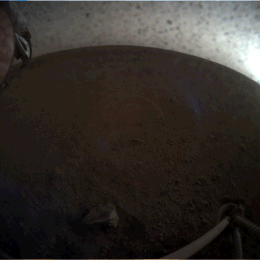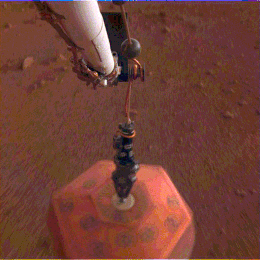Seismic Experiment for Interior Structure
 Testing of the lander's robotic arm that deployed the seismometer | |
| Operator | NASA |
|---|---|
| Manufacturer | CNES |
| Instrument type | geophysical observations |
| Function | seismometer |
| Mission duration | Planned: 2 years on Mars[1] Final: 1446 sols (1485 days) |
| Began operations | Landing: 26 November 2018 |
| Ceased operations | 21 December 2022 |
| Website | www |
| Properties | |
| Mass | 29.5 kg (65 lb)[2] |
| Dimensions | Vacuum chamber volume: 3 L (0.66 imp gal; 0.79 US gal)[2] |
| Power consumption | 8.5 W[2] |
| Data rate | 38 megabits/day [2] |
| Host spacecraft | |
| Spacecraft | InSight |
| Operator | NASA |
| Launch date | 5 May 2018, 11:05 UTC |
| COSPAR ID | 2018-042A |
The Seismic Experiment for Interior Structure (SEIS) is a seismometer and the primary scientific instrument on board the InSight Mars lander launched on 5 May 2018 for a landing on 26 November 2018; the instrument was deployed to the surface of Mars on 19 December. SEIS is expected to provide seismic measurements of marsquakes, enabling researchers to develop 3D structure maps of the deep interior. Better understanding the internal structure of Mars will lead to better understanding of the Earth, Moon, and rocky planetary bodies in general.
SEIS detected marsquakes in Cerberus Fossae in 2019.
On 24 December 2021, the seismometer for the InSight mission on Mars detected a large seismic event with a distinct signature. The event was caused by a meteor impact on the surface of Mars, which was confirmed by satellite observations of a newly formed 150-meter crater. [3] As of 21 December 2022, which marks the official end of the InSight mission, SEIS has detected a total of 1319 marsquakes.[4]
Overview
[edit]Mars flybys and landings to gather scientific data have been conducted since the 1960s, but quality seismological studies – which would provide detailed information about the interior of Mars – have yet to be performed in the 21st century.
Only two astronomical bodies – the Earth and the Moon – have been studied in this way, and learning about Mars is hoped to contribute to understanding the geology of all rocky planetary bodies.
Other onboard instruments working in synergy with SEIS are the Temperature and Winds for InSight module, the Heat Flow and Physical Properties Package, and the Rotation and Interior Structure Experiment.
Earlier missions
[edit]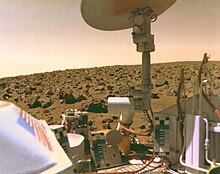
While two seismometers were landed on Mars during the Viking missions in 1976, results were limited.[5] Seismometers on both Viking spacecraft were mounted on the lander, which meant that it also picked up vibrations from various operations of the lander and caused by the wind.[6] In addition, the Viking 1 lander's seismometer did not deploy properly.[7]
The seismometer readings were used to estimate a Martian geological crust thickness between 14 and 18 km (8.7 and 11.2 mi) at the Viking 2 lander site.[8] Unexpectedly, the seismometer also detected pressure from the Mars winds, complementing the meteorology results.[8][9] A single possible candidate for a marsquake was recorded, although it was not confirmed due to the limitations of the design, and interference from other sources of vibration such as wind. Despite these limitations, it was clear that widespread and large marsquakes were not detected.[10]
Design
[edit]SEIS is the primary instrument of the InSight mission, and it was designed and produced by the French Space Agency (CNES), with the participation of the Institut de Physique du Globe de Paris (IPGP), the Swiss Federal Institute of Technology (ETH), the Max Planck Institute for Solar System Research (MPS), Imperial College, Institut supérieur de l'aéronautique et de l'espace (ISAE) and JPL.[11][12] The Principal Investigator is Philippe Lognonné from the Institute of Earth Physics of Paris (Institut de Physique du Globe de Paris), in the E.U.[2]
Its design consists of a 3-axis very-broad-band seismometer (enclosed in a vacuum thermal enclosure) and a 3-axis short-period instrument.[5] Mars is expected to have lower seismic activity than Earth, so minimisation of wind vibrations is critical. The whole assembly is placed under a heavy wind and thermal shield designed to minimize thermal contrasts and offer some protection against gusts of wind.
The tripod-mounted seismometer will take precise measurements of marsquakes and other internal activity on Mars to better understand the planet's history and internal structure. It will also investigate how the Martian crust and mantle respond to the effects of meteorite impacts, which gives clues to the planet's inner structure.[13][14][15] The seismometer will also detect sources including atmospheric waves and gravimetric signals (tidal forces) from Mars' moon Phobos, up to high-frequency seismic waves at 50 Hz.[16][17]
The SEIS instrument is deployed by the Instrument Deployment System, a robotic arm that can position the sensor directly on the surface.[18] The instrument is supported by a suite of meteorological sensors (TWINS) to characterize atmospheric disturbances that might affect the measurements. These include a vector magnetometer provided by UCLA that will measure magnetic disturbances such as those caused by the Martian ionosphere; a suite of air temperature, wind speed and wind direction sensors based on the Spanish/Finnish Rover Environmental Monitoring Station; and a barometer from JPL.[19][20]
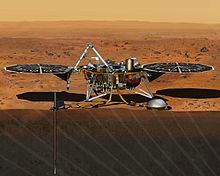
During the final integration of SEIS, several small leaks were found in the vacuum thermal enclosure. This forced the postponement of the InSight launch from 2016 to 2018, and the redesign of a new enclosure under the supervision of JPL.[5][21] The cost of the delay was estimated to be US$150 million.[22]
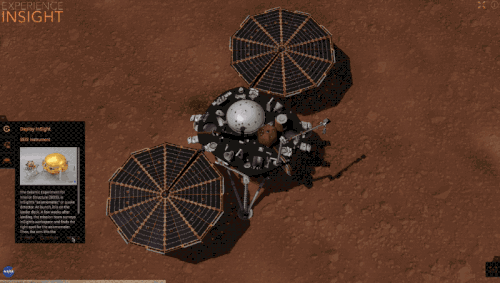
Operations
[edit]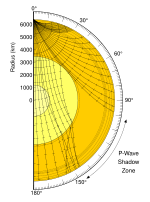
Routine operations will be split into two services, the Mars Structure Service (MSS) and Marsquake Service (MQS), which will be responsible, respectively, for defining the structure models and seismic activity.[16] Combination of data with results from the InSight radio science and orbital observations will allow for constraint of the deeper structure.
Possible observations include:
- P waves and S waves
- Meteor strikes (see also Category:Meteorites found on Mars)
- Marsquakes
- Impact by other manmade objects[23]
- Tidal forces from Mars' moons[24]
- Interior revelations, such as the presence of a solid or liquid core and its size
Single-site seismology
[edit]
During development, the power of multiple sites was noted, but one site offers a tremendous insight to the interior. With a single site, the location of a marsquake event can be constrained to the surface of a sphere, by measuring what are known as P-waves and S-waves.[24]
There is a variety of single-site seismology techniques that can yield data, for example, the detection of an impact on the surface by a meteorite for which the location is identified.[24] If Mars has large marsquakes, they may allow the deep interior to be determined. As the vibrations pass through the planet they are affected by the properties of the materials and its configuration.[24]
For example, the effect of tidal forces on Mars by Phobos, which should be about 10 mm, would be noticeably affected by a liquid Mars core. Even without any marsquake, it should be possible after about six months of observation to use this method to increase or decrease the likelihood Mars has a liquid core.[24]
Cutaway illustration
[edit]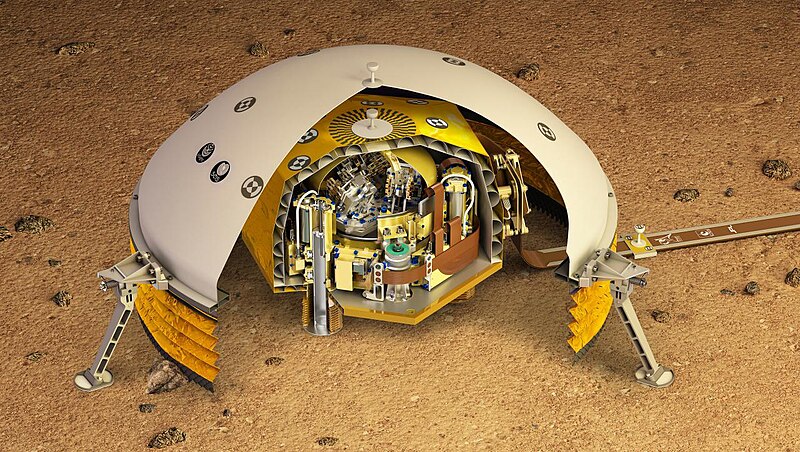
Placement on the surface
[edit]On 19 December 2018, the SEIS instrument was deployed to the surface of Mars next to the lander by its robotic arm.[26]
See also
[edit]References
[edit]- ^ "InSight – Mission Overview". NASA. 2012. Archived from the original on 2013-01-12. Retrieved 22 August 2012.
- ^ a b c d e InSight Seismometer. NASA. Accessed 17 July 2018.
- ^ Posiolova, L. V.; et al. (2022). "Largest recent impact craters on Mars: Orbital imaging and surface seismic co-investigation". Science. 378 (6618): 412–417. Bibcode:2022Sci...378..412P. doi:10.1126/science.abq7704. hdl:10044/1/100459. PMID 36302013. S2CID 253183826.
- ^ ""NASA Retires InSight Mars Lander Mission After Years of Science"". 21 December 2022. Retrieved January 11, 2023.
- ^ a b c SEIS/INSIGHT: One year prior launch for Seismic Discovery on Mars. Lognonne, Philippe; Banerdt, W. Bruce; Giardini, Domenico; Pike, W. Tom; Christensen, Ulli; Knapmeyer-Endrun, Brigitte; de Raucourt, Sebastien; Umland, Jeff; Hurst, Ken; Zweifel, Peter; Calcutt, Simon; Bierwirth, Marco; Mimoun, David; Pont, Gabriel; Verdier, Nicolas; Laudet, Philippe; Smrekar, Sue; Hoffman, Tom. 19th EGU General Assembly, EGU2017, proceedings from the conference held 23–28 April 2017 in Vienna, Austria., p.9978
- ^ Anderson, Don L.; et al. (September 1977). "Signatures of Internally Generated Lander Vibrations" (PDF). Journal of Geophysical Research. 82 (28): 4524–4546, A–2. Bibcode:1977JGR....82.4524A. doi:10.1029/JS082i028p04524.
- ^ "Happy Anniversary, Viking Lander". Science@NASA. NASA. 20 July 2001.
- ^ a b Howell, Elizabeth (6 December 2012). "Viking 2: Second Landing on Mars". Space.com. Retrieved 15 November 2017.
- ^ Nakamura, Y.; Anderson, D. L. (June 1979). "Martian wind activity detected by a seismometer at Viking lander 2 site" (PDF). Geophysical Research Letters. 6 (6): 499–502. Bibcode:1979GeoRL...6..499N. doi:10.1029/GL006i006p00499.
- ^ Lorenz, Ralph D.; Nakamura, Yosio; Murphy, James R. (November 2017). "Viking-2 Seismometer Measurements on Mars: PDS Data Archive and Meteorological Applications". Earth and Space Science. 4 (11): 681–688. Bibcode:2017E&SS....4..681L. doi:10.1002/2017EA000306.
- ^ Francis, Matthew (21 August 2012). "New probe to provide InSight into Mars' interior". Ars Technica. Retrieved 21 August 2012.
- ^ Lognonné, P.; Banerdt, W. B.; Giardini, D.; Christensen, U.; Pike, T.; et al. (October 2011). The GEMS (GEophysical Monitoring Station) SEISmometer (PDF). EPSC-DPS Joint Meeting 2011. 2–7 October 2011. Nantes, France. Bibcode:2011epsc.conf.1507L. EPSC-DPS2011-1507-1.
- ^ "NASA and French Space Agency Sign Agreement for Mars Mission" (Press release). NASA. 10 February 2014. Retrieved 11 February 2014.
- ^ Boyle, Rebecca (4 June 2015). "Listening to meteorites hitting Mars will tell us what's inside". New Scientist. Retrieved 2015-06-05.
- ^ Kumar, Sunil (1 September 2006). Design and development of a silicon micro-seismometer (PDF) (Ph.D.). Imperial College London. Retrieved 2015-07-15.
- ^ a b Planned products of the Mars Structure Service for the InSight mission to Mars Archived 2019-02-14 at the Wayback Machine (PDF). Mark P. Panning, Philippe Lognonne, W. Bruce Banerdt, Raphael Garcia, Matthew Golombek, et al. Space Science Reviews 16 November 2016. doi:10.1007/s11214-016-0317-5
- ^ Banerdt, W. Bruce (2012). InSight – Geophysical Mission to Mars (PDF). 26th Mars Exploration Program Analysis Group Meeting. 4 October 2012. Monrovia, California.
- ^ "Archived copy" (PDF). Archived from the original (PDF) on 2018-09-10. Retrieved 2018-11-24.
{{cite web}}: CS1 maint: archived copy as title (link) - ^ David, Leonard (15 August 2014). "NASA's Next Mars Lander Will Peer Deep Into Red Planet's History: Here's How". Space.com. Retrieved 16 August 2014.
- ^ Banerdt, W. Bruce (7 March 2013). InSight: A Geophysical Mission to a Terrestrial Planet Interior (PDF). Committee on Astrobiology and Planetary Science. 6–8 March 2013. Washington, D.C.
- ^ Clark, Stephen (9 March 2016). "InSight Mars lander escapes cancellation, aims for 2018 launch". Spaceflight Now. Retrieved 9 March 2016.
- ^ Foust, Jeff (28 March 2016). "InSight's second chance". The Space Review. Retrieved 2016-04-05.
- ^ Fernando, Benjamin; Wójcicka, Natalia; Froment, Marouchka; Maguire, Ross; Stähler, Simon C.; Rolland, Lucie; Collins, Gareth S.; Karatekin, Ozgur; Larmat, Carene; Sansom, Eleanor K.; Teanby, Nicholas A. (2021). "Listening for the Landing: Seismic Detections of Perseverance's arrival at Mars with InSight". Earth and Space Science. 8 (4): e2020EA001585. Bibcode:2021E&SS....801585F. doi:10.1029/2020EA001585. hdl:20.500.11937/90005. ISSN 2333-5084.
- ^ a b c d e f "Geophysical Network Mission for MARS 2009" (PDF). Archived from the original (PDF) on 2016-06-03. Retrieved 2018-11-23.
- ^ Webster, Guy; Brown, Dwayne (May 22, 2014). "NASA Mars Weathercam Helps Find Big New Crater". NASA. Retrieved May 22, 2014.
- ^ a b Cook, Jia-Rui; Good, Andrew (19 December 2018). "NASA's InSight Places First Instrument on Mars". NASA. Retrieved 20 December 2018.

